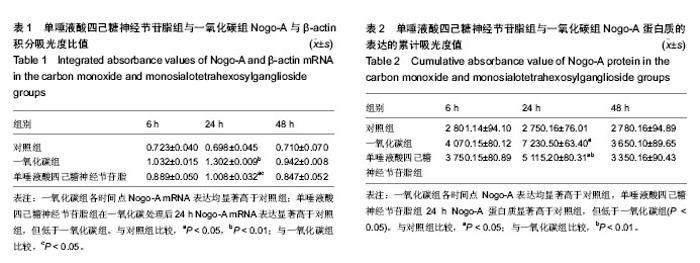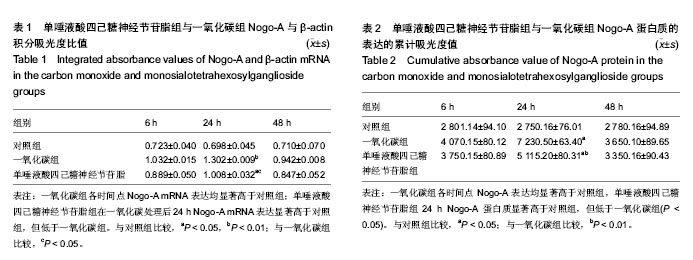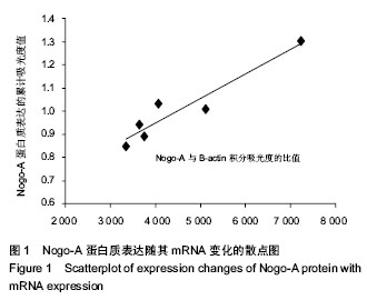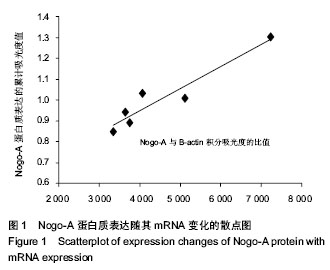| [1] Wu PE, DN Juurlink. Carbon monoxide poisoning. Cmaj.2014; 186(8): 611.
[2] Pernet V, Schwab ME. The role of Nogo-A in axonal plasticity, regrowth and repair. Cell Tissue Res, 2012. 349(1): 97-104.
[3] Fu ZZ,Lu H,Jiang JM,et al.Methylprednisolone inhibits Nogo-A protein expression after acute spinal cord injury. Neural Regen Res. 2013;8(5): 404-409.
[4] Saha N, Kolev M, Nikolov DB. Structural features of the Nogo receptor signaling complexes at the neuron/myelin interface. Neurosci Res. 2014;87:1-7.
[5] Wang YD,Liu YG,Liu Q.Ganglioside promotes the bridging of sciatic nerve defects in cryopreserved peripheral nerve allografts. Neural Regen Res. 2014;9 (20): 1820-1823.
[6] Yu RK, Tsai YT, Ariga T. Functional roles of gangliosides in neurodevelopment: an overview of recent advances. Neurochem Res.2012;37(6): 1230-1244.
[7] 校建波,王立鹤,付国强.神经节苷脂在急性一氧化碳中毒早期脑保护治疗中的意义[J]. 临床误诊误治, 2014,27: 72-74.
[8] Peng X, Liu S,Ye J,et al.Downregulation of Nogo-A expression of oligodendrocytes in vitro with antisense oligodeoxynucleotides. Yan Ke Xue Bao.2003;19(3):195-200.
[9] Baumann N, Pham-Dinh D.Biology of oligodendrocyte and myelin in the mammalian central nervous system. Physiol Rev.2001;81(2): 871-927.
[10] Chen ZJ, Ughrin Y, Levine JM.Inhibition of axon growth by oligodendrocyte precursor cells. Mol Cell Neurosci.2002;20(1): 125-139.
[11] 胡建国,陆佩华,徐晓明.少突胶质细胞生物学功能与相关疾病研究进展[J]. 生理科学进展, 2004,35(1): 39-41.
[12] Fournier AE, Gould GC, Liu BP, et al. Truncated soluble Nogo receptor binds Nogo-66 and blocks inhibition of axon growth by myelin. J Neurosci.2002;22(20):8876-8883.
[13] Liu BP, Fournier A, GrandPré T, et al.Myelin-associated glycoprotein as a functional ligand for the Nogo-66 receptor. Science.2002;297(5584): 1190-1193.
[14] Thom SR, Bhopale VM, Fisher D, et al.Delayed neuropathology after carbon monoxide poisoning is immune-mediated. Proc Natl Acad Sci U S A.2004;101(37): 13660-13665.
[15] Wang CY, Li Jinsheng. Expressions of the astrocytes and oligodendrocytes in rat models of delayed neuropathological sequelaeaer CO poisoning and the efect of hyperbaric oxygen treatment on the two kinds of neuroglia cell. China Crit Care Med.2007;27: 615-618.
[16] 王树兴,彭龙锋,曲绍霞,等.神经节苷脂对重型颅脑创伤患者血清Nogo-A蛋白水平的影响[J].山东医药, 2012, 52(3):71-74.
[17] Cheatwood JL, Emerick AJ, Schwab ME, et al. Nogo-A expression after focal ischemic stroke in the adult rat. Stroke. 2008;39(7):2091-2098.
[18] Liu JR, Ding MP, Wei EQ, et al.GM1 stabilizes expression of NMDA receptor subunit 1 in the ischemic hemisphere of MCAo/reperfusion rat. J Zhejiang Univ Sci B. 2005;6(4): 254-258.
[19] Hu H, Pan X, Wan Y, et al.Factors affecting the prognosis of patients with delayed encephalopathy after acute carbon monoxide poisoning.Am J Emerg Med. 2011;29(3):261-264.
[20] 王寅旭,王晓明,陈芳,等.急性一氧化碳中毒后迟发性脑病的预后因素分析[J].中华脑血管病杂志:电子版, 2011,5(6):499-504.
[21] 周春燕,贾宏禔.生物化学[M]. 7版,北京:人民卫生出版社. 2008: 332-343
[22] Lin LC, Ho FM, Yen SJ, et al. Carbon monoxide induces cyclooxygenase-2 expression through MAPKs and PKG in phagocytes. Int Immunopharmacol. 2010;10(12):1520-1525.
[23] Verma A, Hirsch DJ, Glatt CE, et al.Carbon monoxide:A putative neural messenger.Science.1993; 259:381-384.
[24] Otterbein LE, Bach FH, Alam J, et al. Carbon monoxide has anti-inflammatory effects involving the mitogen -activated protein kinnase pathway.Nat Med. 2000; 6: 422-428.
[25] Zhen G, Xue Z, Zhang Z, et al. Carbon monoxide inhibits proliferation of pulmonary smooth muscle cells under hypoxia. Chin Med J (Engl). 2003;116(12):1804-1809. |



